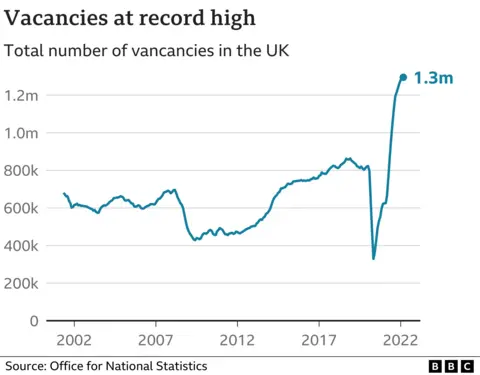Job vacancies outpace unemployment for first time
 Getty Images
Getty ImagesThere are more job vacancies than unemployed people in the UK for the first time since records began.
The unemployment rate fell to 3.7% between January and March, its lowest for almost 50 years, as job openings rose to a new high of 1.3 million.
However, wages, excluding bonuses, failed to keep pace with rising prices, a problem expected to intensify because of growing food and fuel costs.
The figures show "a mixed picture" said the Office for National Statistics.
Ben Harrison, director of the Work Foundation think tank at Lancaster University, said: "Despite employment continuing to rise, today's figures underline the challenges facing workers who are seeing inflation eat away at their living standards."
The data showed that there was a rise in the number of people moving from economic inactivity - classed as those aged 16-64 who haven't been working or seeking a job - into employment.
At the same time, people moving from job-to-job also reached a record high "driven by resignations rather than dismissals", said the ONS.
"Total employment, while up on the quarter, remains below its pre-pandemic level," said Darren Morgan, director of economic statistics at the ONS.
"Since the start of the pandemic, around half a million more people have completely disengaged from the labour market," he added.
"However, job vacancies are still rising, reaching yet another record high."
The situation is "a nightmare", said Buddy Love, who along with his wife Kate runs the Flying Fish pub, restaurant and hotel in Somerset.
Mr Love said it has taken him six weeks and £2,000 worth of job adverts to find a new chef for his kitchen - and in the end it was word of mouth that delivered the right candidate rather than any advertisement.
 Buddy Love
Buddy Love "I don't know where these people are," said Mr Love, adding that he had offered a good starting salary of £36,000 and perks such as free accommodation to entice the right person.
Luckily, a Romanian couple, who had previously worked in the UK, will soon take up the role as a job share, freeing Mr Love from the kitchen so he can focus on his main job of "developing the business and making sure it grows".
Wages
Pay, excluding bonuses, rose by 4.2% between January and March but failed to keep up with the rising cost of living - which hit 7% in March and is expected to go higher.
It meant that pay, when adjusted for the impact of rising prices, and excluding bonuses, dropped by 1.2% - the biggest fall since 2013.
Some sectors such as construction and financial services benefitted from bonus payments as firms put up pay to recruit staff, the ONS said. This saw total pay, which includes bonuses, rise by 7% between January and March, keeping pace with rising prices.
Mr Morgan said: "Continued strong bonuses in some sectors such as construction and especially finance mean that total pay is continuing to grow faster than prices on average, but underlying regular earnings are now falling sharply in real terms."


It is a tale of three jobs markets told in these figures.
The unemployment rate falling to its lowest level in almost half a century is a testament to the full recovery from the losses in the pandemic and the protections put in place over the past two years.
For many millions in employment however pay, when adjusted for surging inflation, fell by the biggest amount for over 9 years and that is set to get worse.
And then for businesses seeking workers - those vacancies reached a new record of close to 1.3 million. This is a reflection of a reduction in the size of the workforce, from post-Brexit worker rules, older workers retiring during the pandemic and a rise in long term sickness.
So considering the hit from the pandemic, these are a very good set of figures, looking backwards. But they don't yet, except in the real earnings figures, show the impact of the ongoing inflationary economic squeeze.
Indeed, such is the extent of the hit to consumer spending power, the Bank of England and others see the economy heading into recessionary territory and unemployment starting to rise by hundreds of thousands.
The Government hopes that as many of the remaining jobless can be squeezed into these vacancies. The fear is that this situation is overtaken by the dark inflationary clouds

Pay has been failing to keep up with the cost of living for some months, as fuel, energy and food prices surge higher due to the pandemic and Ukraine war.
Official data on Wednesday is expected to show another sharp rise in the cost of living for April, reflecting last month's hike in the energy price cap.
The Bank of England warned earlier this month that the cost crunch is set to leave the UK on the brink of recession, with inflation peaking at over 10% later this year and the jobs market slowing down.

Commenting on the latest figures, Chancellor Rishi Sunak said: "I understand that these are anxious times for people, but it's reassuring that fewer people are out of work than was previously feared."
But Liberal Democrat Treasury spokesperson Christine Jardine said: "These figures confirm families are facing a cost of living nightmare, with wages failing to keep up with soaring energy bills and food prices."
Looking ahead, Jake Finney, economist at accountancy firm PwC, said the jobless rate could begin to tick higher.
"We expect that unemployment could start to rise towards the end of this year, as headwinds from the war in Ukraine reduce demand for labour.
"The delayed impact is because the labour market tends to lag behind the rest of the economy".
